Podcast: Play in new window | Download
With business aircraft, the pre-purchase inspection is an important due-diligence tool: revealing risk and uncovering value. Here, the details, the data, and decades of front-line experience drives smart spending decisions.
Our expert today, Don Sebastian, knows the pre-by ecosystem intimately and today he’s sharing his specific pre-purchase pointers gathered over 30+ years in the field.
Don has conducted pre-purchase inspections examining every centimeter of various business aircraft lives from paperwork to paint to systems to service bulletins in big boeings to timeless tailwheels helping prospective owners/operators make appropriate buying and pricing decisions… leveraging the pre-purchase process to protect them and their money.
Jet Pre-Purchase Investigation
A pre-purchase inspection is really an investigation. The aim: finding defects (squawks) with the airplane from paperwork to computers to components. What’s the key? Knowing where to go to find these squawks.
This investigation starts in the office. Think, paperwork trail. Securing the airworthiness, registration, and computerized aircraft maintenance reports (CAMP) through various government and manufacture channels reveals the high-level history of the asset and helps with early decision making.
Do any items on the airplane expire soon? Example: the engine turbine blades can come with lifetime limits before inspection or replacement is required. The CAMP report will show it so you can negotiate a favorable sales solution.
Where has the airplane been? Did it live in a hangar or outside in a salty-air environment. Like collector cars, airplanes stored indoors in dry areas typically have less corrosion than airplanes that sat outside in a salty-air environment. This finding might drive decisions on additional, more intrusive pre-purchase inspections later on.
Did this airplane undergo major repairs due to damage? The airworthiness investigation will show what was repaired and who did the reapair(s) (was it an authorized repair center). Why does this matter? Value. Simply put, a previously-damaged asset almost always costs less than an original-condition asset. Airplanes work exactly the same.
The paperwork and documentation helps tell the airplane’s story before you…
Tour & Flight Test The Business Jet
When the above items check out, nothing beats seeing an airplane in person. Don recommends taking a test flight using a specific checklist and flight plan. Why?
An aircraft’s flight manual outlines all performance metrics. For instance, at 30,000 feet the airspeed should be X and the fuel flow should be Y. With the anti-ice system on, engine power should be Z. Comparing actual performance with manufacturer published-performance can expose well-working equipment or hidden defects.
Flying the jet also allows for pressurization tests. Don once found a pressure bulkhead crack during a high altitude test flight. What would be the chances of spotting this defect on the ground? Low (he heard a whistling noise during the pre-purchase test flight, which revealed this problem).
After landing, more tests tell more of the story. Single-engine operations confirm that emergency systems function correctly. An experienced ear can pick up abnormal engine shutdown noises. Full fuel tanks, that sit overnight, offer opportunities to locate any leaks.
Don’s 30 years in this niche, his Airline Transport Pilot, and his multiple aircraft ratings help him run through tests like these so the buyer makes the best check-writing decisions when it comes time to…
Repair or Renegotiate Terms
Armed with information, the buyer is now able to make decisions.
What (if any) items must be fixed for the deal to proceed? What more-intrusive inspections should be performed? What items should be overhauled now (before due) since that specific part of the airplane is “opened up” during the manufacturer inspections ordered. By the way, what manufacturer inspection(s) matter most?
Thinking outside the box here helps ensure every squawk discovered in the process above is satisfactorily addressed.
Data, Details, & Business Jet Buying Decisions
In this game, the titles, bullet points, sub-bullet points, and sub-sub-bullet points can domino into seemingly endless holes.
The avionics will be outdated in two years. Replacing them now means upgrading both avionics and software versions. Updating software means replacing circuit boards. Replacing circuit boards means installing improved (and required per manufacturer bulletins) control valves. If you have the airplane apart for these things, it might make sense to replace the carpet. If carpet is getting replaced, should we refurbish the seats and sidelines, too?
The dominos can keep falling later if important items are not discovered now during the pre-purchase investigation. Don’s humble perspective and knowledge in this process can spot future problems and prevent unexpected cost overruns years after closing the deal.
Mentioned In The Show
Aviation Consulting Services, Inc.
Don Sebastian: 910 – 528 -7769
Comments
What have you learned today about the business jet pre-purachse inspection process?
Share your view, in the comments below, or confidentially here.
Subscribe in iTunes | Give an iTunes Rating (here’s how)






[…] has also had appearances on several other podcasts like: AviatorCast, The Inspired Pilot, Private Jet, AirplaneGeeks (Episode 336 and 366), and of course The […]